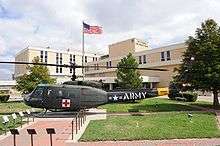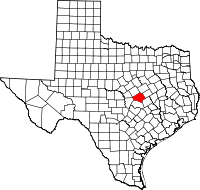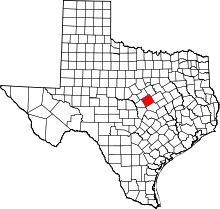Fort Hood
| Fort Hood | |
|---|---|
| Killeen, Texas | |
|
Shoulder sleeve insignia of major units stationed at Fort Hood | |
| Coordinates | 31°08′N 97°47′W / 31.13°N 97.78°W |
| Type | Army post |
| Site information | |
| Controlled by | United States Army |
| Site history | |
| Built | 1942 |
| In use | 1942–present |
| Garrison information | |
| Current commander | LTG Sean MacFarland |
| Garrison |
III Corps 85th Civil Affairs Brigade 1st Medical Brigade Operational Test Command 13th Financial Management Center 407 Army Field Support Brigade 48th Chemical Brigade 69th Air Defense Artillery Brigade 57th and 62nd Expeditionary Signal Battalions |
Fort Hood is a U.S. military post located in Killeen, Texas. The post is named after Confederate General John Bell Hood. It is located halfway between Austin and Waco, about 60 miles (100 km) from each, within the U.S. state of Texas.
Its origin was the need for wide-open space to test and train with World War II tank destroyers. The War Department announced the location in January 1942, and the initial completion was set for that August. As originally constructed, Fort Hood had an area of 158,706 acres (64,226 ha), with billeting for 6,007 officers and 82,610 enlisted personnel. The main cantonment of Fort Hood had a total population of 53,416 as of the 2010 U.S. Census. Fort Hood is the most populous U.S. military installation in the world.[1] The main business area is in Bell County, with the training countryside area of the post in Coryell County. In April 2014, the Fort Hood website lists 45,414 assigned soldiers and 8,900 civilian employees with Fort Hood covering 214,000 acres (87,000 ha).[2]
History
Origins
During World War II, tank destroyers were developed to counter German mobile armored units. These were mobile anti-tank guns on armored halftracks or specially developed tanks. Wide-open space was needed for the tank destroyer testing and training, which Texas had in abundance. Andrew Davis (A.D.) Bruce was assigned to organize a new Tank Destroyer Tactical and Firing Center, and he chose Killeen, Texas for the new camp.[3] The War Department announced the selection on 15 January 1942. An initial acquisition of 108,000 acres (169 mi² / 437 km²) was made, and it was estimated that the camp would cost $22,800,000 for the land, facilities, and development of utilities. The date of completion was set for 15 August 1942.
About 300 families had to move from their homes to make room for the camp area and the communities of Clear Creek, Elijah, and Antelope were demolished to facilitate construction of the base. The old Sugar Loaf community, historically called the "Cradle of Killeen," provided the city with many of its first citizens in 1882. All that remains of the community is the mountain from which it took its name, located in the Fort Hood area. To lessen the burden of moving, the Army agreed to allow land to be used for grazing for a nominal grazing fee. This grazing arrangement still continues today.
In mid-August the camp was occupied and the official opening took place on 18 September 1942. Camp Hood was named for the Confederate General John Bell Hood, who gained recognition during the Civil War as the commander of Hood's Texas Brigade.
The original facilities provided housing and training sites for nearly 38,000 troops. In January 1943, an additional 16,000 acres (65 km²) in Bell County and 34,943 acres (141 km²) in Coryell County near Gatesville, Texas were purchased. The site near Gatesville was known as the sub-camp and later as North Camp Hood. During the war years, North Camp Hood housed nearly 40,000 troops and 4,000 prisoners of war, and was the site for the southern branch of the United States Disciplinary Barracks.
At the end of 1942 there were about 45,000 troops living and training at Camp Hood and in late June 1943 it peaked at almost 95,000 troops, which was maintained until early 1944.
In 1944 the number of tank destroyer battalions in training at Camp Hood declined rapidly. Field artillery battalions and the Infantry Replacement Training Center replaced them in March 1944. By September, the Infantry Center was the largest activity on post with 31,545 troops. The total camp population on the last day of 1944 was 50,228.
During the last year of World War II Camp Hood's mission shifted and its population drastically decreased. As the war came to an end, troop training slowed and the priorities were equipment reclamation and demobilization. A separation center was established in September 1945, and as the year ended, post strength had fallen to 1,807 prisoners and about 11,000 troops.
In mid-1954, III Corps moved from California to Fort Hood. The Corps supervised the training of combat units at Fort Hood and other Fourth Army stations from 1954 to 1959 when III Corps was inactivated. Probably the most famous trainee to come through Fort Hood was Elvis Presley, arriving on 28 March 1958. Other than receiving record amounts of mail (3–4 bags per day), he was treated like all other trainees. On 19 September, Presley shipped out for Germany. During this period, the 4th Armored Division was reactivated and deployed to Germany as part of the "Gyroscope" concept of unit movement. In 1958, the 4th Infantry Division was selected to be the sole infantry component in the Strategic Army Corps (STRAC) and assigned the mission to suppress aggression wherever American interests were threatened.
In September 1961, Fort Hood again became the home for the III Corps, and in February 1962, III Corps was assigned as part of the U.S. Army Strategic Army Corps (STRAC). On 15 June 1963 Killeen Base was turned over to the Army.
In October 1969, Killeen Base was designated as West Fort Hood and the airfield's name was designated as Robert Gray Army Airfield. The base was named after a Killeen native who was a pilot of a B-25 bomber on the famous Doolittle Raid on Tokyo in 1942. He was killed later in World War II flying combat missions. With the redesignation came a change in mission at West Fort Hood. Nuclear weapons were removed; they had been secretly kept there since 1947.[4]
During the late 1960s Fort Hood trained and deployed a number of units and individuals for duty in Vietnam. As the United States ended its role in the conflict, thousands of returning soldiers completed their active duty with one of the divisions. During this time, the post was modernized. On 13 September 1965 Darnall Hospital opened. In 1970, construction began on Palmer Theater and Venable Village was dedicated. Modern barracks were springing up around post. The wood buildings of Fort Hood were replaced with brick structures.
In September 1967, Fort Hood was officially designated a two-division post with the 1st and 2d Armored Divisions.
In 1971 the colors of the 1st Cavalry Division came to Fort Hood from Vietnam, resulting in the reflagging of the 1st Armored Division, the colors of which were sent to Germany to reflag the 4th Armored Division.
From 23 December 1972 to 19 January 1973, Elements of the 13th Support Brigade deployed to the 1972 Nicaragua earthquake to assist in disaster relief serving at Camp Christine, Managua, Nicaragua.
Since the early 1970s, Fort Hood has played a major role in the training, testing, and introduction of new equipment, tactics, and organizations. The U.S. Army Training and Doctrine Command's Test and Experimentation Command (now the U.S. Army Operational Test Command), located at West Fort Hood has been A primary player. Fort Hood fielded the M1 Abrams tank, M2/3 Bradley Infantry/Cavalry Fighting Vehicle, the Multiple Launch rocket System (MLRS), and the AH-64 Apache helicopter.
In January 1975, the 1st Cav "First Team" was reorganized, as the Army's newest armored division. Since fielding the M-1 Abrams in 1980, force modernization has continued as a major focus. The First Team became the first division to field the AH-64 Apache attack helicopter, M2 Bradley Fighting Vehicle, the Humvee, the Multiple Launch Rocket System and Mobile Subscriber Equipment (MSE) tactical communications.
Army expeditions 1990–2000
In August 1990, Fort Hood was alerted for deployments to Southwest Asia as part of the joint forces participating in Operation Desert Shield. The deployment to Saudi Arabia began in September, extending into mid-October.
on 21 May 1991 with the reactivation of its 3rd Brigade ("Greywolf") the 1st Cavalry Division became the largest division in the Army upon its return to the United States. In October 1992 the Engineer Brigade, 1st Cavalry Division was reactivated. Through the Engineer Restructuring Initiative, the nucleus of the brigade was formed around the 8th Engineer Battalion. The 20th Engineer Battalion was brought from Fort Campbell, KY, to join the brigade, and the 91st Engineer Battalion was activated to complete the brigade.
In November 1992, the unit designations for the battalions remaining from the former "Tiger" Brigade of the 2nd Armored Division were returned prior to 2nd AD's activation at Fort Hood on 2 December 1992. This action was done to realign the historical designations of units to their parent divisions. On 29 November 1992, the 3d Battalion, 41st Infantry was designated as the 1st Battalion, 9th Cavalry; 1st Battalion, 67th Armor to 3d Battalion, 8th Cavalry, and 1st Battalion, 3rd Field Artillery to 2d Battalion, 82d Field Artillery. On 16 December 1992, 1st Cavalry Division units designated to accomplish realignments for historical purposes and included the 1st Battalion, 32d Armor reflagged as 2d Battalion, 12th Cavalry; 3d Battalion, 32d Armor to 1st Battalion, 12th Cavalry; and Battery A, 333d Field Artillery to Battery B, 26th Field Artillery.
During the post war periods called Operation Desert Calm and Operation Provide Comfort, Fort Hood units continued to serve in the Persian Gulf area. From December 1992 to May 1993, Fort Hood soldiers deployed to Somalia for Operation Restore Hope to command and control the Joint Task Force Support Command. In the fall of 1994, Fort Hood units participated in the largest deployment since Operation Desert Shield and Desert Storm executed split base operations in the Caribbean Basin, Central America and Southwest Asia, in support of Operations Vigilant Warrior and Sea Signal V, as well as other contingency operations.
13th COSCOM Commander Brig. Gen. Billy K. Solomon deployed along with a portion of the headquarters in December 1992 to Mogadishu to serve as the nucleus of Joint Task Force Support Command. Their major units included the 593d Support Group (Fort Lewis), 36th Engineer Group (Fort Benning), 7th Transportation Group (Fort Eustis), and 62d Medical Group (Fort Lewis). Soldiers of the Lucky 13th returned to Fort hood in May 1993.
As a result of the Base Realignment and Closure Commission (BRAC) reductions, the 5th Infantry Division (Mechanized), then located at Fort Polk Louisiana, was reflagged as the U.S. 2nd Armored Division in late 1992. By mid-1993 the division at Fort Hood had completed changes of unit names to those associated with the 5th Division, and began participation in the early stages of the Army's Experimental Force, Force XXI.
In 1995, the 2nd Armored Division was reflagged as the U.S. 4th Infantry Division. Twenty-five years after making its home in Colorado, the Ironhorse Division was again restationed to meet the Army's requirements but this move would be quite different from others. The Ironhorse Division became a split-based organization with six brigades and three separate battalions stationed at Fort Hood and the 3rd Brigade Combat Team remaining at Fort Carson. By December 1995 The 4th Infantry Division (Mechanized) assumed responsibility as the Army's Experimental Force (Force XXI), and on 15 December 1995 its colors were unfurled for the first time over central Texas and Fort Hood.
Since the 1990s, Fort Hood units have supported Operation Joint Endeavor in Bosnia and Herzegovina. In October 1998, The 1st Cavalry Division was the first United States division to assume authority of the Multinational Division (North) area of operation in Bosnia-Herzegovina. The mission was to conduct operations to enforce the military provisions set forth by the Dayton Peace Accords.
In 1998, the Ironhorse Division was designated to be the Army's first Multi-Component unit. The main objective being to enhance Total Force integration, optimize the unique capabilities of each component, and improve the overall readiness of the Army. The program was developed to leverage the strengths of the Army's three components (active, reserve and National Guard). As such, 515 positions within the division have been designated as reserve component. These positions include individuals, a unit from the Wyoming National Guard and dual-mission units from the Texas Army National Guard.
In addition to peacekeeping efforts, Fort Hood units routinely participate in national and international disaster relief efforts. Hours after the 1985 Mexico City earthquake, III Corps units were ready to move out to provide assistance. Fort Hood units also aided Managua, Nicaragua, after an earthquake ravaged the city.
During the 1990s, Fort Hood continued an extensive building program to modernize the post. This modernization continues today, with emphasis on quality of life, force projection and training. The Robertson Blood Center, Soldier Development Center, and a new commissary at Warrior Way have been completed. Many other improvements were made to improve the Power Projection Mission of the post such as improvements to the railhead and the runway at Gray Army Airfield. Training ranges have been upgraded.
Army expeditions 2000 until 2009
At the beginning of the 21st century the Army's modernization was in full swing. Some of thes new advances in technology and war fighting included the fielding of the M1A2 Abrams Main Battle Tank, the M2A2 Operation Desert Storm (ODS) Bradley Infantry Fighting Vehicle, the M109A6 Paladin Howitzer, the OH-58D Kiowa Warrior, the AH-64D Apache Longbow Helicopter, and the M6 Bradley Linebacker.
Fort Hood was the first installation selected to privatize post housing under the residential communities initiative. Under this initiative, new housing units, remodeled housing and community improvements will be added to the post.
In 2001, the war on terror became a prime focus. Fort Hood transitioned from an open to a closed post with the help of military police from reserve units. The 1st Cav sent additional troops to Kuwait to protect against possible aggressive actions from Iraq. The 4003rd Garrison Support Reserve unit fills vacancies left by deploying units at Fort Hood. Fort Hood has a key role as a training base for mobilizing Reserve and National Guard units to support the Homeland Defense effort.
Many Fort Hood units have deployed to Afghanistan for Operation Enduring Freedom, and to Iraq for Operation Iraqi Freedom. In December 2003, the 4th Infantry Division captured Saddam Hussein. In the spring of 2004, the 1st Cavalry Division followed the 4th Infantry Division deploying to Iraq. Task Force ODIN was created at Ft. Hood.
In September 2005, 13th COSCOM and key enablers were called to support Joint Task Force Katrina/Rita hurricane relief and went on to serve as the senior joint logistical support command for JTF Katrina. 13th COSCOM eventually provided one hundred million rations, collected human remains with dignity, executed emergency engineering operations, transported, distributed and stored over one billion dollars in humanitarian relief from both non-governmental and federal sources from across the nation.
In 2009, Fort Carson, Colorado's First Army Division West re-stationed to Fort Hood in order to consolidate its mission to conduct Reserve Component mobilization training and validation for deployment, switching places with 4th Infantry Division, which relocated to Fort Carson.[5]
2007 navigation exercise incident
On 12 June 2007, the body of Lawrence George Sprader, Jr was found at about 8:30 p.m. in a brushy area located within the Central Texas Army post's training ground. He had gone missing for days while conducting an exercise for testing basic map-reading and navigation skills. A massive search had been conducted, with over 3000 parties scouring the countryside. According to autopsy records, he had died from hyperthermia and dehydration.[6] According to an Army investigatory report, there were "a multitude of procedural violations, judgment errors and alleged acts of misconduct by Army trainers that not only contributed to Sprader's death but put some 300 other soldiers in danger that day, including about two dozen who required medical attention."[7]
2009 shooting
On 5 November 2009, a gunman opened fire in the Soldier Readiness Center of Fort Hood and killed 13 people while wounding 32 others. Nidal Malik Hasan, a U.S. Army Major and psychiatrist, was the gunman. He was non-fatally shot and then arrested by Department of the Army police officers Sergeant Mark Todd and Sergeant Kimberly Munley.[8][9][10]
Eyewitnesses to the actual events said: "...Major Hasan wheeled on Sergeant Munley as she rounded the corner of a building and shot her, putting her on the ground. Then Major Hasan turned his back on her and started putting another magazine into his semiautomatic pistol. It was at that moment that Senior Sgt. Mark Todd, a veteran police officer, rounded another corner of the building, found Major Hasan fumbling with his weapon and shot him."[11]
In 2013, Hasan was convicted of thirteen counts of premeditated murder[12] and thirty-two counts of attempted premeditated murder for the thirty soldiers and two civilian police officers injured in the shooting.[13] On 23 August 2013, Hasan was found guilty on all charges and was sentenced to death.[14]
2011 attack plot
Pfc. Naser Jason Abdo, an AWOL private, was arrested near Fort Hood, and in a statement by the police chief of Killeen, Texas, the man told investigators that he wanted to attack fellow soldiers at the military post.[15] At his trial in August 2012, Abdo stated, through a cloth mask, "I will continue until the day the dead are called to account for their deeds." Abdo was sentenced to life in prison for the attempted attack.[16]
2014 shooting
On 2 April 2014, a shooting spree occurred at several locations on the base, leaving three people dead and sixteen others wounded. The gunman then died from a self-inflicted gunshot wound.[17][17][18] He was later identified as 34-year-old Ivan Lopez, an Iraq War veteran.[19][20]
2014 prostitution ring scandal
On 3 June 2014, a woman testified to a Fort Hood hearing board that the sexual assault prevention officer on base forced her into a prostitution ring.[21]
The woman described how when she was 20, she was struggling to buy groceries for her preschool aged child after her husband left her and drained their bank account. According to UT San Antonio Associated Press, "Anu Bhagwati, executive director of Service Women's Action Network and a former captain with the Marine Corps, said prostitution rings are not uncommon within the military and the allegations against McQueen were no surprise."
"Institutionally, a lot of inappropriate behavior is condoned," she told The Associated Press. "Women are so few within the military still that I think predators look at women as fresh meat and the military as an institution where they can get away with criminal activity."[22]
The woman told the board that "Basically, it was having sex with higher ranking officers for money."[23] McQueen, who is no longer responsible for sexual assault prevention duties, is facing charges of pandering, conspiracy, adultery and sexual assault.
According to the Military Times, "Investigators believe that McQueen, 37, persuaded a female private first class to become a prostitute who sold sex to other servicemembers, according to a senior defense official and Capitol Hill staffer who have been briefed on the investigation. It is the latest in a string of sex scandals to rock the military. Earlier this month, the Air Force officer in charge of sexual abuse prevention was arrested near the Pentagon, accused of drunkenly groping a woman. His trial is slated for July. Last week, the Pentagon announced that incidents of sexual assault had jumped 35 percent from 2010 to 2012, hitting 26,000. McQueen was working as a sexual harassment/assault response and prevention (SHARP) coordinator when he recruited the woman."[24]
McQueen also approached another woman in an alleged attempt to get her to join the prostitution ring. She complained to military officials that after she refused, he sexually assaulted her.[24]
In the court-martial of U.S. vs. Sgt. 1st Class Gregory McQueen on March 12, 2015 Military Judge Lt. Col. Rebecca Connally determined McQueen was guilty of having committed the following offenses.
- Four specifications of Article 80 (attempt to pander)
- Three specifications of Article 81 (Conspiracy to patronize/soliciting a prostitute)
- Three specifications of Article 92 (Failure to obey a lawful order/dereliction of duty)
- Two specifications of Article 93 (Cruelty and Maltreatment)
- Three specifications of Article 134 (Adultery/pandering and prostitution)
McQueen was also charged for one specification of Article 128, assault consummated by a battery, which was tried on the merits as he did not plead guilty to this particular offense. Connally announced that McQueen was guilty of this offense.
The sentence adjudged in McQueen’s court-martial was a reduction to the grade of E-1, 24 months confinement and a dishonorable discharge.[25]
2014 until present
Currently, Fort Hood has nearly 65,000 soldiers and family members and serves as a home for the following units: Headquarters III Corps; First Army Division West; the 1st Cavalry Division; 13th Sustainment Command (formerly 13th Corps Support Command); 89th Military Police Brigade; 504th Battlefield Surveillance Brigade; 85th Civil Affairs Brigade; 1st Medical Brigade; and the 69th Air Defense Artillery Brigade. Fort Hood also includes Carl R. Darnall Army Medical Center and the Medical And Dental Activities as tenant units.[26]
As of October 2015 Killeen, Texas started a land use study, to “identify and mitigate compatibility and encroachment issues that may impact training, operations".[27]
Anti-war activity
Fort Hood has served as a hub for anti-war activity during both the Vietnam War (e.g. the "Fort Hood Three" incident) and the War on Terror.
From 1968-1972, the Oleo Strut was a G.I. coffeehouse located near post in Killeen, Texas.[28] The coffee house was featured in the documentary Sir! No Sir!.[29]
In 2009, the tradition of The Oleo Strut continued when the Under the Hood Café opened. The location serves as an outreach center for antiwar activists to reach out to area soldiers, and provide them with support.[28] Under the Hood Cafe announced on 10 Nov. 2014 that it would close by the end of the year.[30]
Recently several soldiers supported by Under the Hood have taken public acts of resistance, including Amnesty International Prisoner of Conscience[31] Travis Bishop.[32][33][34]
Demographics

As of the census[35] of 2000, there were 33,711 people, 5,819 households, and 5,679 families residing in the Fort Hood CDP. The population density was 2,255.7 people per square mile (870.6/km²). There were 5,941 housing units at an average density of 397.5 per square mile (153.4/km²). The racial makeup of the CDP was 50.7% White, 31.6% African American, 1.2% Native American, 2.1% Asian, 0.8% Pacific Islander, 8.7% from other races, and 4.8% from two or more races. 16.7% of the population were Hispanics or Latinos of any race.
There were 5,819 households out of which 87.6% had children under the age of eighteen living with them, 87.1% were married couples living together, 8.2% had a female householder with no husband present, and 2.4% were non-families. 2.0% of all households were made up of individuals and 0.0% had someone living alone who is sixty-five years of age or older. The average household size was 3.92 and the average family size was 3.95.
The age distribution was 33.3% under the age of eighteen, 32.3% from eighteen to twenty-four, 33.1% from twenty-five to forty-four, 1.2% from forty-five to sixty-four, and 0.1% who were sixty-five years of age or older. The median age was twenty-one years. For every one hundred females there were 163.4 males. For every one hundred females over the age of eighteen there were 209.4 males. All of these statistics are typical for military bases.
The median income for a household on the base was $32,552, and the median income for a family was $32,296. Males had a median income of $18,884 versus $17,101 for females. The per capita income for the CDP was $11,078. 9.5% of the population and 8.3% of families were below the poverty line. Out of the total population, 11.0% of those under the age of eighteen and 25.8% of those sixty-five and older were living below the poverty line.
Military base



Fort Hood is one of the largest United States military installations in the world, and is the home of III Corps, 1st Cavalry Division, 13th Sustainment Command, First Army Division West, 3rd Armored Cavalry Regiment, 41st Fires Brigade and many other Forces Command and other units.
The 4th Infantry Division completed its move from Fort Hood to Fort Carson, Colorado, exchanging positions with several units. The 4th Infantry Division Museum closed at Fort Hood for the last time on 29 May 2009 to complete its move to Colorado although most of the outdoor pieces remained at Fort Hood as part of the new 3CR Museum.[36]
Before the breakup of the Soviet Union, Fort Hood was billed as the largest military base in the free world (Fort Benning is larger in personnel, Fort Bliss in land area). During peacetime, Fort Hood is a gated post, with the 1st Cavalry Division Museum, the Belton Lake Outdoor Recreation Area (BLORA), and a number of other facilities that are open to the public. Access to the cantonments became restricted starting on 12 September 2001. However, passes are available to visit the two museums on post, and the lake area remains open to the public without restriction since it is outside the cantonments. Various events, including the annual Independence Day celebration, which has one of the largest fireworks displays in the country, are open to the public.
Shortly after the 2000 census, responsibility for post housing was turned over to privatized partnership with Actus Lend Lease. Under the terms of the contract, most of the housing has been remodeled or rebuilt, and hundreds of new units have been built or are in the process of being built, operating as Fort Hood Family Housing. The nine schools on Fort Hood are part of the Killeen Independent School District.
Fort Hood consists of three sections: the main cantonment, West Fort Hood, and North Fort Hood. The main cantonment is bounded by Killeen on the east and Copperas Cove on the west. The Fort Hood main cantonment area, otherwise referred to as Main post, holds its own airfield, Hood Army Airfield. North Fort Hood is bounded by Gatesville to the northwest. West Fort Hood, bounded by Killeen and Copperas Cove, includes Fort Hood's second airfield, Robert Gray Army Airfield, which has been expanded for civilian use (Killeen-Fort Hood Regional Airport (GRK)) and additional training areas. To the east and southeast, the reservation is bounded by Harker Heights, Nolanville, Belton, and Morgan's Point Resort.
Notable residents
- Tamera Mowry – actress
- Tia Mowry – actress
- Elvis Presley – singer, actor
- Lucas Till – actor
- Geoff Ramsey – film producer, actor
- Robert Griffin III – football player
- Donald Buckram – football player
- Josh Lovelady – football player
- Jackie Robinson – baseball player
- Anna Todd – author
See also
References
- ↑ James Ragland (December 6, 2009). "Tested by tragedy, Fort Hood family of civilians and soldiers deserve Texan of the Year honor". Dallas Morning News. Retrieved May 4, 2013.
"Bangor native to head leadership group". Bangor Daily News. April 10, 1985. Retrieved May 4, 2013. - ↑ "Fatalities reported in Fort Hood shooting". CNN. 2 April 2014.
- ↑ "Lt. Gen Andrew Davis Bruce". Texas Historical Marker Atlas. Texas Archival Resources Online. 2000. Retrieved 25 June 2007.
- ↑ Fort Hood: The Great Place to Call Home, Fort Hood's Official Post Guide, Fort Hood History, page 72. Marcoa Publishing Inc., 2004, under contract with Fort Hood. Editorial content edited and prepared by the Public Affairs Office of Fort Hood.
- ↑ "Force Structure Actions at Fort Hood,". U.S. Army Public Affairs. Retrieved 5 June 2009.. Archived 8 June 2009.
- ↑ "Hyperthermia, dehydration killed Fort Hood GI". msnbc.
- ↑ Angela K. Brown (28 August 2007). "AP: Report faults trainers in soldier's death". USA Today.
- ↑ "Fort Hood Gunman Who Killed 12, Wounded 30 Survived Gun Battle". ABC.
- ↑ "Deadly shootings at US army base". BBC News. 6 November 2009. Retrieved 2 May 2010.
- ↑ Root, Jay (Associated Press), "Officer Gives Account of the Firefight at Fort Hood", Arizona Republic, 8 November 2009.
- ↑ McKinley Jr, James C. (13 November 2009). "Second Officer Gives an Account of the Shooting at Ft. Hood". The New York Times. Retrieved 2 May 2010.
- ↑ "Fort Hood suspect charged with murder". Cnn.com. Retrieved 12 November 2009.
- ↑ "Further charges for alleged Fort Hood gunman". Ft.com.
- ↑ "Nidal Hasan convicted of Fort Hood killings". Washington Post. Retrieved 23 August 2013.
- ↑ CNN:Justice Official: Soldier said he wanted to attack Fort Hood troops CNN, 29 July 2011.
- ↑ Naser Jason Abdo Sentenced To Life For Fort Hood Plot by Sarah Kuta. The Huffington Post, 10 August 2012.
- 1 2 Herskovitz, Jon (April 2014). "Shooter at Fort Hood Army base in Texas, injuries reported - police". Reuters. Retrieved 2 April 2014.
- ↑ "Fort Hood shooter snapped over denial of request for leave, Army confirms". Fox News Channel. 7 April 2014. Retrieved 12 April 2014.
- ↑ Stableford, Dylan; Eric Pfeiffer (3 April 2014). "Fort Hood shooting leaves 4 dead, including gunman; 16 injured". Yahoo!. Retrieved 3 April 2014.
- ↑ "Fort Hood Shooting: What We Know About Ivan Lopez". The Huffington Post. 3 April 2014. Retrieved 12 April 2014.
- ↑ New York Daily News: Goldstein Fort Hood sexual assault prevention officer ran on-base prostitution ring: witness NY Daily News, 4 June 2014.
- ↑ "Private testifies in Fort Hood prostitution case". Associated Press, UT San Diego. 3 June 2014. Retrieved 3 June 2014.
- ↑ McGuiness, Chris (June 2014). "Female soldier testifies in Fort Hood prostitution ring scandal". Kdhnews. Retrieved 3 June 2014.
- 1 2 Tom Vanden Brook Suspect in Fort Hood prostitution ring identified Military Times, 15 May 2014.]
- ↑ Sentence announced in US vs. Sgt. 1st Class Gregory McQueen Fort Hood Press Center
- ↑ "Fort Hood home page". Fort Hood home page. Retrieved 21 January 2016.
- ↑ Jacob Brooks and JC Jones (10 October 2015). "Study takes aim at commercial encroachment that could impact training at Fort Hood". Temple Daily Telegram. FME News Service. Retrieved 12 October 2015.
- 1 2 "Under the Hood - Oleo Strut History". Underthehoodcafe.org. 4 July 1968. Retrieved 2012-07-20.
- ↑ Washington Post: Veterans Fighting for Peace. 19 May 2006.
- ↑ http://underthehoodcafe.org/2014/11/goodbye-to-college-street/
- ↑ USA: Soldier imprisoned as conscientious objector: Travis Bishop Amnesty International Prisoner of Conscience website, 24 August 2009.
- ↑ The Olympian: Soldier who refused Afghan tour released. 2 April 2010.
- ↑ Soldier Gets Year In Jail Killeen Daily Herald, 15 August 2009, Rebecca LaFlure. Retrieved 5 November 2009.
- ↑ U.S. Soldier Who Didn't Obey Is Jailed New York Times, 5 August 2009, James McKinley Jr. Retrieved 5 November 2009.
- ↑ "American FactFinder". United States Census Bureau. Retrieved 2011-05-14.
- ↑ "Ivy Division museum preparing for move to Fort Carson". dvidshub.
- ↑ Krammer, Arnold (1979). Nazi Prisoners of War in America. New York: Stein and Day. p. 268. ISBN 0812825713.
- Cragg, Dan, Sgt. Maj. (USA Ret.), The guide to military installations, Stackpole Books, Harrisburg, 1983
External links
| Wikimedia Commons has media related to Fort Hood, Texas. |









